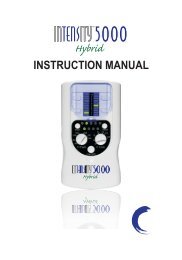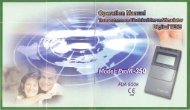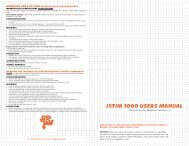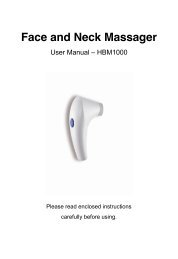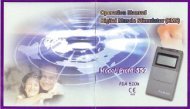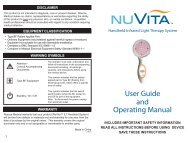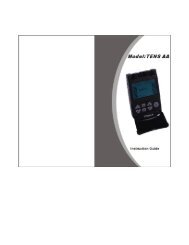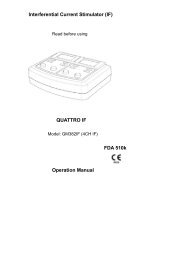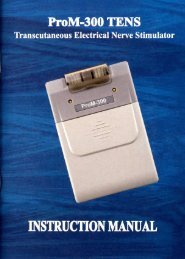TENS EV-803P Manual - Current Solutions LLC
TENS EV-803P Manual - Current Solutions LLC
TENS EV-803P Manual - Current Solutions LLC
Create successful ePaper yourself
Turn your PDF publications into a flip-book with our unique Google optimized e-Paper software.
PULSE RATE<br />
The Pulse Rate (hertz or pulses per second) chosen depends greatly<br />
upon the type of electrode placement given to the patient.<br />
When using contiguous and dermatome electrode placements (i.e.<br />
stimulating directly through the area of pain or localized enervation),<br />
a quick pulse rate (setting greater than 80Hz on the Pulse Rate<br />
Control) is desired. The patient should not perceive individual pulses<br />
but rather have the sensation of steady continuous stimulation.<br />
When using point treatments, it has been suggested that slow pulses<br />
be utilized (less than 10Hz). With this setting the patient should be<br />
able to slightly perceive individual pulses.<br />
When using multiple electrode placement strategies, such as<br />
combinations of point and contiguous electrode placements, the<br />
quicker pulse rates are suggested.<br />
Despite above recommendations, these individual patients may<br />
require slight variations of the above settings, according to the nature<br />
of their condition.<br />
TREATMENT MODE<br />
Normal or Conventional <strong>TENS</strong> offers the practitioners complete control<br />
over all the various treatment parameters of the instrument.<br />
Burst Mode is analogous to the Low Rate <strong>TENS</strong> technique except the<br />
low frequency individual pulses are replaced by individual “bursts”<br />
of 7-10 individual pulses. It is thus a combination of Conventional<br />
<strong>TENS</strong> and Low Rate <strong>TENS</strong>. In Burst Mode, the treatment frequency<br />
is adjustable at the range between 0.5Hz – 5Hz.<br />
Modulated Mode attempts to prevent nerve accommodation by<br />
continuously cycling the treatment intensity. When using Modulated<br />
Mode increase the intensity only when the unit is at the maximum<br />
intensity of the modulation cycle. If the intensity is increased during<br />
a low intensity period of the cycle, the patient may turn up the control<br />
very slowly, so that they may feel the intensity any higher.<br />
12<br />
IN<strong>TENS</strong>ITY<br />
Each patient responds differently to different levels of intensity, due<br />
to varying degrees of tissue resistance, enervation, skin thickness,<br />
etc. Intensity instructions are therefore limited to the following settings:<br />
Perception – The intensity is increased so that the patient can feel<br />
the stimulation, but there is not any muscular contraction.<br />
Slight Contraction – Intensity is increased to a barely visible muscular<br />
contraction that is not strong enough to move a joint. When using<br />
low pulse rate settings, this will show as individual twitches. At<br />
higher pulse rates there will simply be increased muscle tension.<br />
Strong muscular contraction is typically not used in <strong>TENS</strong> therapy.<br />
However, muscular contraction may be useful if the pain involves a<br />
cramped or spastic muscle.The <strong>TENS</strong> can be used as a traditional<br />
muscle stimulator in the circumstances to quickly break the spasm.<br />
Use a quick pulse rate, wide pulse duration and set the intensity to<br />
visible contraction (still within patient tolerance). Twenty or thirty<br />
minutes of such a tetanized muscular contraction will generally break<br />
the spasm. In all cases, if the patient complains that the stimulation is<br />
uncomfortable, reduce intensity and/or cease stimulation.<br />
TIME DURATION<br />
The onset of pain relief should occur shortly after the intensity setting<br />
has been determined. However, in some cases, pain relief may take<br />
as long as 30 minutes to achieve, especially when using point<br />
electrode placements and slow pulse rates.<br />
<strong>TENS</strong> units are typically operated for long periods of time, with a<br />
minimum of 20 – 30 minutes and in some post-operation protocols, as<br />
long as 36 hours.<br />
In general, pain relief will diminish within 30 minutes of the cessation<br />
of stimulation. Pain relief obtained through point electrode placements<br />
may last longer (perhaps because of the presence of endorphins).<br />
13<br />
PDF created with FinePrint pdfFactory trial version http://www.pdffactory.com



